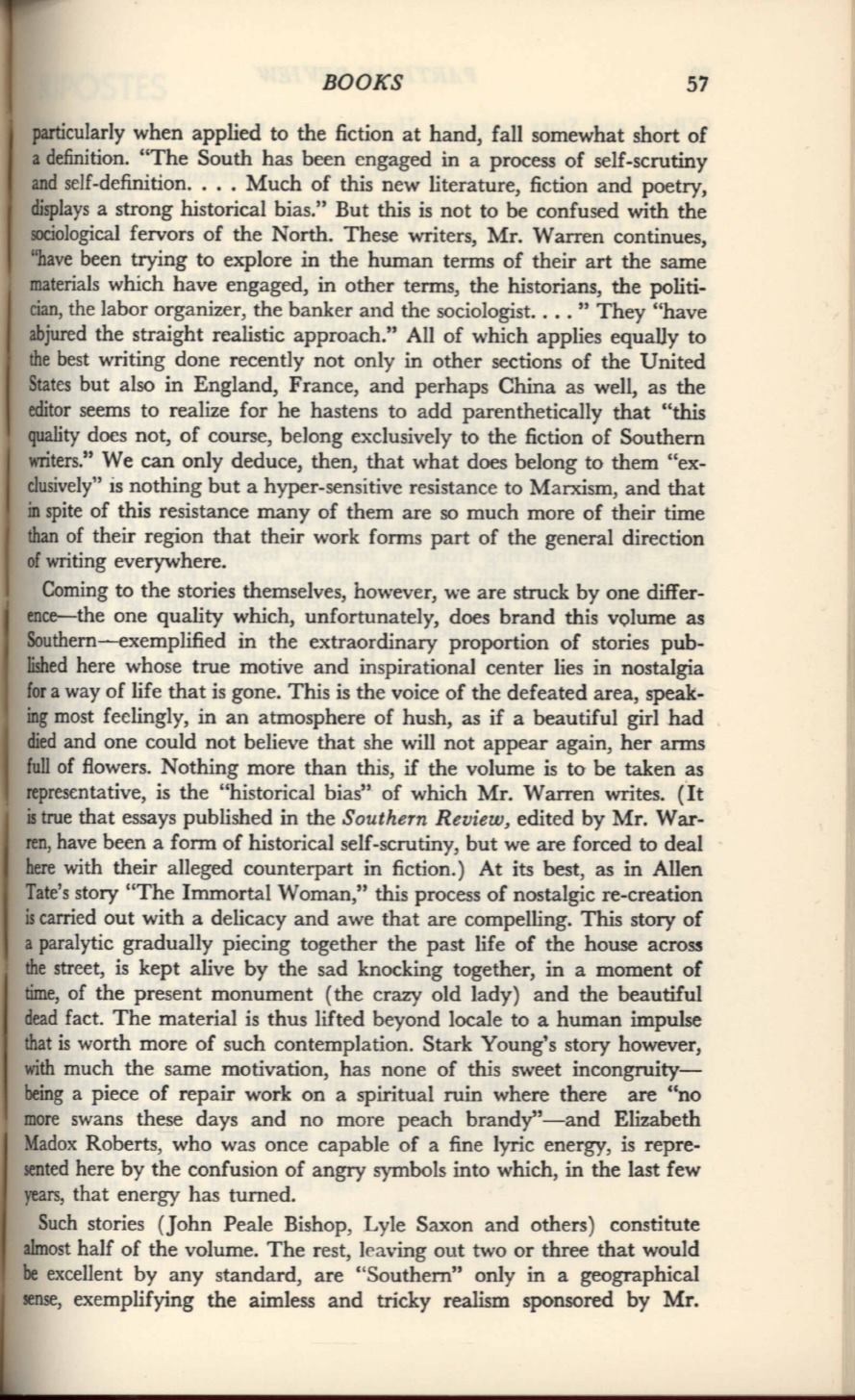
particularly when applied to the fiction at hand, fall somewhat short of
a definition. "The South has been engaged in a process of self-scrutiny
andself-definition ....
Much of this new literature, fiction and poetry,
displaysa strong historical bias." But this is not to be confused with the
sociologicalfervors of the North. These writers, Mr. Warren continues,
"havebeen trying to explore in the human terms of their art the same
materialswhich have engaged, in other terms, the historians, the politi-
cian,the labor organizer, the banker and the sociologist .... " They "have
abjured the straight realistic approach." All of which applies equally to
thebest writing done recently not only in other sections of the United
Statesbut also in England, France, and perhaps China as well, as the
editorseems to realize for he hastens to add parenthetically that "this
qualitydocs not, of course, belong exclusively to the fiction of Southern
writers."We can only deduce, then, that what does belong to them "ex-
clusively"is nothing but a hyper-sensitive resistance to Marxism, and that
inspite of this resistance many of them are so much more of their time
thanof their region that their work forms part of the general direction
oC
writing everywhere.
Coming to the stories themselves, however, we are struck by one differ-
ence-the one quality which, unfortunately, does brand this volume as
Southern-exemplified in the extraordinary proportion of stories pub-
lishedhere whose true motive and inspirational center lies in nostalgia
Cor
a way of life that is gone. This is the voice of the defeated area, speak-
ingmost feelingly, in an atmosphere of hush, as if a beautiful girl had
diedand one could not believe that she will not appear again, her arms
Cullof flowers. Nothing more than this, if the volume is to be taken as
representative, is the "historical bias" of which Mr. Warren writes. (It
istrue that essays published in the
Southern Review,
edited by Mr. War-
ren,have been a form of historical self-scrutiny, but we are forced to deal
herewith their alleged counterpart in fiction.) At its best, as in Allen
Tate'sstory "The Immortal Woman," this process of nostalgic re-creation
iscarried out with a delicacy and awe that are compelling. This story of
a paralytic gradually piecing together the past life of the house across
the street, is kept alive by the sad knocking together, in a moment of
time,of the present monument (the crazy old lady) and the beautiful
deadfact. The material is thus lifted beyond locale to a human impulse
thatis worth more of such contemplation. Stark Young's story however,
withmuch the same motivation, has none of this sweet incongruity-
beinga piece of repair work on a spiritual ruin where there are "no
more swans these days and no more peach brandy" -and Elizabeth
MadoxRoberts, who was once capable of a fine lyric energy, is repre-
sentedhere by the confusion of angry symbols into which, in the last few
years,that energy has turned.
Such stories (John Peale Bishop, Lyle Saxon and others) constitute
almosthalf of the volume. The rest, leaving out two or three that would
be excellent by any standard, are "Southern" only in a geographical
sense,exemplifying the aimless and tricky realism sponsored by Mr.
BOOKS
57


